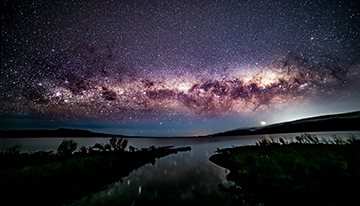After five years of hard work by a small group of volunteers, the South Wairarapa and Carterton Districts have been formally certified as an International Dark Sky Reserve Named Wairarapa Dark Sky Reserve
The new Reserve covers an area of 3,665 square kilometres. Ideally the site is surrounded by enduring protection from significant light encroachment, with the Pacific Ocean to the east and south and the Remutaka and Tararua forest ranges to the west.
With broad community support, it ensures the region’s dark skies would not degrade, a problem that besets some 80 percent of people worldwide. It will preserve the region’s pristine night skies for future generations.
“We are thrilled to be granted kaitiaki (guardianship) status for our sparkling dark skies by the International body, the International Dark-Sky Association,” Wairarapa Dark Sky Association chair Viv Napier said. We know there are massive environmental and social benefits from reducing the scatter of light at night, and we want to thank the communities of Martinborough, Featherston, Greytown, and Carterton for their support,” she added.
The Wairarapa now joins 21 International Dark Sky Reserves around the world, and one other New Zealand dark sky reserve in the Aoraki-Mackenzie region. Covering an area of 3665 square kilometres, it is hoped the Wairarapa reserve will in time be extended to include Masterton.
To support the application, South Wairarapa District Council approved a change to the Wairarapa Combined District Plan in 2021 to minimise light pollution in the night sky. This included changes to lighting rules around sports grounds and the rollout of downward tilting, warm-coloured street lights that contain the light’s spread.
The reserve is expected to bring significant economic benefits from astro-tourism, particularly because of the Wairarapa’s accessibility. As an activity which improves in winter, stargazing is also expected to tie in nicely with local winter events such as Featherston Booktown and Greytown’s Mid-Winter Christmas festival.
A founding member of the Dark Sky Association, Ray Lilley, said Tekapo’s astro-tourism section was generating more than $1 million a day before Covid, although that was not the key objective. “We like to think of ourselves as a conservation organisation first, with a focus on preserving the dark sky above us.
Dark Sky Reserves require a core area of quality sky and natural darkness, and a peripheral area that supports the core’s preservation. For Wairarapa, the core zone will be the Aorangi Forest Park, a 194sq km protected area managed by the Department of Conservation.
Lilley said the application process was rigorous, requiring applicants to demonstrate robust community support for dark sky protection. However, the association had had “tremendous support, particularly from the councils, and a degree of good fortune”.
Aside from supporting the reserve application, switching the district’s street lighting to dark sky compliance is expected to also have several other benefits. It should reduce electricity costs, maintain the natural environment for plants and animals, and should enable residents to sleep better with lower light levels.
Support from community groups, including local iwi and astronomical societies in Wairarapa and Wellington, as well as the region’s four local councils – South Wairarapa, Carterton, Masterton, and Greater Wellington Regional Council – was integral to the success of this certification.



